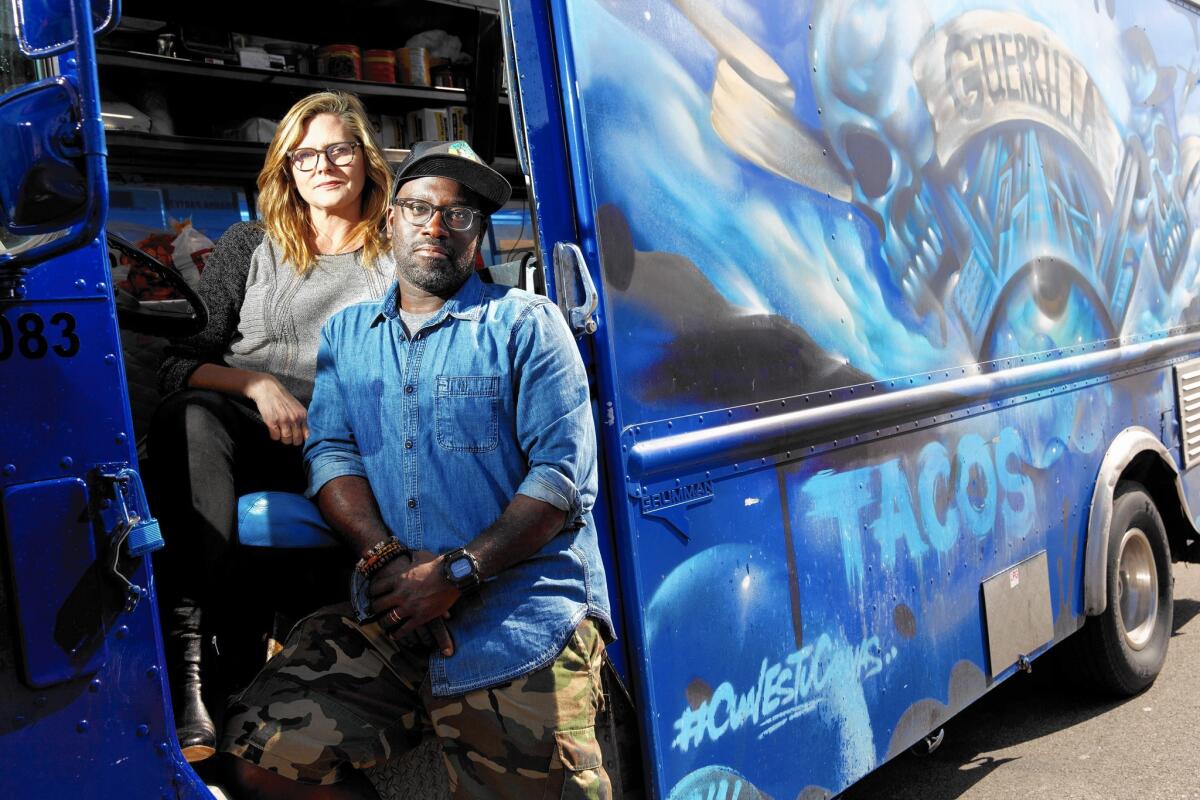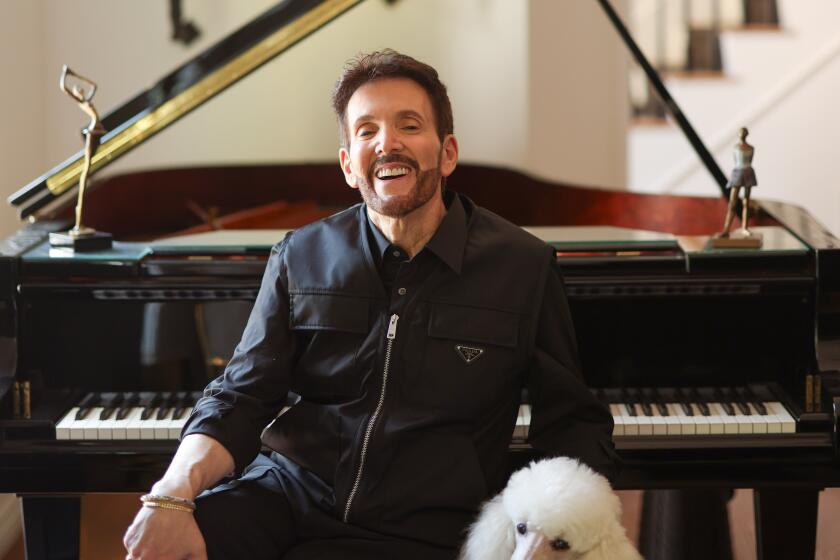Los Angeles is the guest of honor at Jonathan Goldâs table in âCity of Goldâ

The star of the new documentary âCity of Goldâ is Times restaurant critic Jonathan Gold, who in 2007 became the first food writer to win a Pulitzer Prize and who has democratized food criticism by treating L.A.âs diverse array of unassuming, hole-in-the-wall eateries as potential temples of haute cuisine.
But the true subject, the title suggests, is the city itself.
Director Laura Gabbert and cinematographer Jerry Henry, residents of L.A., spent several years following Gold, his appetite and his intrepid curiosity from Boyle Heights to Leimert Park to Koreatown to Alhambra, stopping at strip malls, taco trucks and hot dog carts, a process that inspired a new way of seeing and filming this diverse and sprawling metropolis.
SIGN UP for the free Indie Focus movies newsletter >>
âCity of Gold,â which screened at the 2015 Sundance and South by Southwest film festivals and is opening in limited release on March 11 from IFC Films, treats Los Angeles as a moving target. The filmmakers use on-screen maps, birdâs-eye-view overhead shots and dreamlike street-level footage to find a visual corollary for a city without a center.
Over lunch at the Gold-approved Guerrilla Tacos, a mobile kitchen parked (for the day) in the downtown arts district, Gabbert and Henry explained their attempts to spotlight an underrepresented Los Angeles through what the film calls âculinary mapping.â
âLos Angeles is hard to get right,â Gabbert said, citing a line from Thom Andersenâs influential documentary âLos Angeles Plays Itself,â a wide-ranging critique of the movie industryâs false and misleading representations of the city. âThe horizontality of L.A., the vastness of it, makes it hard to capture in like three shots. ⌠It was really important to me that we captured Jonathan Goldâs Los Angeles, which is something very specific â gritty and ugly but also beautiful. You start to see that beauty after you live here a long time.â
Gabbert admitted that âa year into shooting, I thought, âWhat am I doing, making a film about a writer?â Itâs hard to make it cinematic. But Jonathanâs writing is very visual. His descriptions are so strong.â As a director, she found herself inspired by Goldâs attention to detail. âThe light was really, really important, the glare in your windshield, a little bit of smog, the feeling of driving through the city.â
Goldâs vision of Los Angeles is premised on the idea that Angelenos should be willing to leave their comfort zones, endure freeway traffic and negotiate language barriers in search of a spectacular meal. In the film, Gold refers to the city as an âanti-melting pot,â and his reviews often focus on traditional, region-specific restaurants owned by recent immigrants catering to the tastes of their own communities.
âHeâs actively trying to make Los Angeles a place where all these different neighborhoods and cultures can connect,â Henry said. âHe makes an effort to find those nooks and crannies, those places people may not know about.â
Avoiding obvious local signifiers, âCity of Goldâ may be the only documentary about Los Angeles that doesnât feature a shot of the ocean. For Henry, who shared cinematography duties with Goro Toshima, the quest for evocative B-roll footage mirrored Goldâs obsessive journeys in search of birria or galbi jjim.
He traveled to a series of far-flung L.A. locations, where he would âcamp myself out on a corner and hang out there for hours and shoot interesting people or scenics.â In addition, he used a drone camera to offer an aerial perspective of the Southland, and he often shot from a moving car to emphasize the âtransitional blurâ between neighborhoods.
Surprisingly, Gabbert describes herself as ânot a food person,â but sheâs aware that celebrity gourmands like Anthony Bourdain and Guy Fieri have turned the cuisine-centric travelogue into a formulaic TV genre. âThere was a conscious effort not to do perfectly lit food shots,â she said. âWe didnât really interview the cooks in the kitchen, and ask, âWhatâs that sauce youâre putting on there?â The fact that itâs Los Angeles through Jonathanâs eyes keeps it in a separate, nonreality TV box.â
Still, âCity of Goldâ offers several pleasures that wouldnât seem out of place on the Food Network, taking viewers inside the cramped quarters of Roy Choiâs Kogi BBQ truck and capturing the panic on chef Ludo Lefebvreâs face when Gold makes an unannounced visit to his Trois Mec restaurant.
From his home in Pasadena, Gold rambles far and wide in a gas-guzzling pickup truck, happily insulated from the eco-conscious ethos of many liberal Angelenos â a contingent that includes his own brother, Mark, an associate vice chancellor at UCLAâs Institute of the Environment and Sustainability. Incorporating clips from a 1972 BBC documentary, âCity of Goldâ likens its protagonist to the late English historian and critic Reyner Banham, a famously optimistic admirer of car-centric sprawl who referred to the freeway âAutotopiaâ as one of the âfour ecologiesâ that make Los Angeles so unique.
âCity of Gold,â whose protagonist describes his understanding of the taco as âoverly romantic,â offers an almost utopian vision of urban life in which good food can temporarily transcend borders of race, class and gender.
Itâs a vision that resonates with Henry: âMy familyâs Caribbean, and my wife is from Singapore. The common thread is we both have curry â the British influence. When we met, we were talking about hot cross buns and curry, and I was thinking, âHow do you know about that?â And she was thinking, âHow do you know about that?ââ
Since she premiered the documentary at Sundance last year, Gabbert says audiences have regularly told her that they want to visit Los Angeles and explore the cityâs less familiar neighborhoods and enclaves.
She sometimes offers a different suggestion: âThe hope is that people take back [Goldâs] mode of exploration and apply it to their own city. Not every city has a Jonathan Gold, but you can still do it.â
MORE:
Jonathan Goldâs 101 Best Restaurants | Map
Otium at the Broad museum is L.A.âs most ambitious new restaurant in years
Jonathan Goldâs 10 best dishes of 2015
Jonathan Goldâs 5 best L.A. burritos
More to Read
Only good movies
Get the Indie Focus newsletter, Mark Olsen's weekly guide to the world of cinema.
You may occasionally receive promotional content from the Los Angeles Times.










